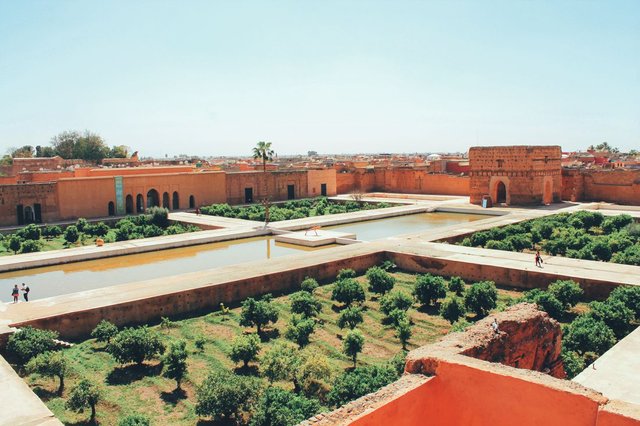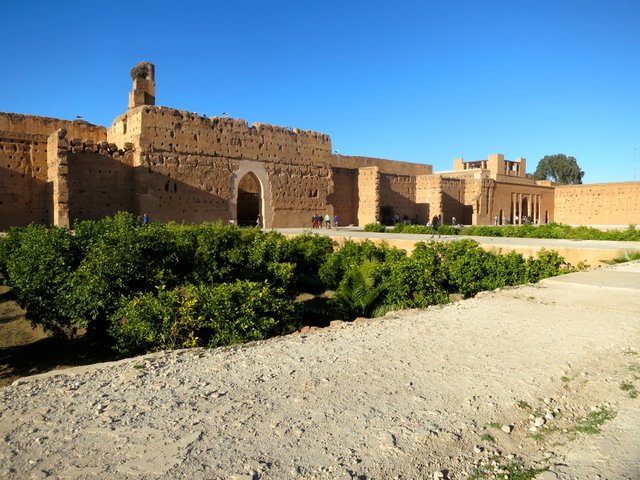Marrakech : Elbadii Palace
The El Badii palace (sometimes spelled El Badiî palace or El Badia, literally "palace of the incomparable") is an architectural ensemble built at the end of the sixteenth century and located in Marrakesh, Morocco. Former palace, it was built by the Saadian Sultan Ahmed al-Mansur Dahbi to celebrate the victory over the Portuguese army, in 1578, in the battle of the Three Kings. Today, there remains only a huge esplanade carved gardens, planted with orange trees and surrounded by high walls. Indeed, in 1696, the Alawite sultan Moulay Ismaïl took what was richest in this palace to build the imperial city of Meknes. Since 2011, the El Badi Palace has been used as a stage for the Marrakech Laughter Festival, organized by Jamel Debbouze.
The building was erected on the northeastern corner of the Kasbah, not far from the private apartments of Saadian Sultan Ahmed al-Mansur Dhahbi. The construction of the palace took place from 1578 to 1594, some works remaining however until 1603, date of the death of the sultan. Symbol of power, the palatial ensemble expressed the splendor of the sovereign both with his subjects and foreign embassies: he was the setting for solemn audiences and parties. Considered a jewel of Islamic art, its construction was influenced by the Alhambra of Granada (Spain).

Le palais El Badii (parfois orthographié palais El Badiî ou El Badia, littéralement « palais de l’incomparable ») est un ensemble architectural construit à la fin du xvie siècle et situé à Marrakech au Maroc. Ancien palais, il fut édifié par le sultan saadien Ahmed al-Mansur Dahbî pour célébrer la victoire sur l’armée portugaise, en 1578, dans la bataille des Trois Rois. Aujourd’hui, il ne reste qu’une immense esplanade creusée de jardins, plantée d’orangers et entourée de hauts murs. En effet, en 1696, le sultan alaouite Moulay Ismaïl a pris ce qu’il y avait de plus riche dans ce palais pour construire la ville impériale de Meknès. Depuis 2011, le palais El Badi est utilisé comme scène pour le festival du Marrakech du Rire, organisé par Jamel Debbouze.
L’édifice fut érigé sur le coin nord-est de la Casbah, non loin des appartements privés du sultan saadien Ahmed al-Mansur Dhahbî. L’édification du palais se déroula de 1578 à 1594, certains travaux perdurant toutefois jusqu’en 1603, date de la mort du sultan. Symbole de puissance, l’ensemble palatial exprimait le faste du souverain tant auprès de ses sujets que des ambassades étrangères : il était le cadre d’audiences solennelles et de fêtes. Considéré comme un joyau de l’art islamique, sa construction fut influencée par l’alhambra de Grenade (Espagne).

وقصر البديع (الذي تم تهجئته أحيانًا قصر البديع أو البادية ، حرفياً "قصر لا مثيل له") هو عبارة عن مجموعة معمارية مبنية في نهاية القرن السادس عشر وتقع في مراكش بالمغرب. القصر السابق ، بناه سلطان السعدي أحمد المنصور الداهي للاحتفال بالانتصار على الجيش البرتغالي ، في 1578 ، في معركة الملوك الثلاثة. واليوم ، لا يبقى سوى حدائق كبيرة منحوتة مزروعة بأشجار البرتقال ومحاطة بجدران عالية. في الواقع ، في عام 1696 ، اتخذ السلطان العلوي مولاي إسماعيل ما كان أغنى في هذا القصر لبناء مدينة مكناس الإمبراطورية. منذ عام 2011 ، تم استخدام قصر البادي كمرحلة لمهرجان مراكش للضحك ، الذي نظمه جمال الدبوز.
تم بناء المبنى على الركن الشمالي الشرقي من القصبة ، وليس بعيداً عن الشقق الخاصة بسعدان سلطان أحمد المنصور الظاهري. استغرق بناء القصر من 1578 إلى 1594 ، وبعض الأعمال المتبقية حتى عام 1603 ، تاريخ وفاة السلطان. رمز السلطة ، أعربت الفرقة فخم روعة سيادة مع كل من رعاياه والسفارات الأجنبية: كان الإعداد للجمهور الرسمي والأحزاب. يعتبر جوهرة من الفن الإسلامي ، وتأثر بناؤه من قصر الحمراء في غرناطة (اسبانيا).